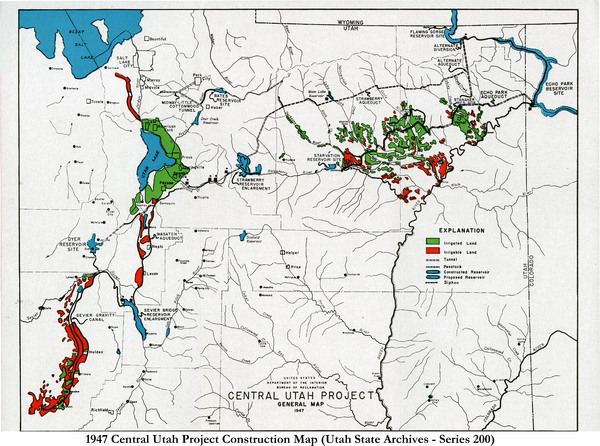Dublin Core
Title
Description
By the mid-twentieth century, the water of the Colorado River and its tributaries became increasingly attractive to Utah’s growing population. But there were two big problems. First, this water flowed through a watershed far away from Utah’s population center on the Wasatch Front. Second, there were six other Western states who had claims on it. The Central Utah Project – or CUP – aimed to tackle the physical challenges of diverting and storing that water, while solidifying Utah’s claim to its portion.
The CUP became the largest water infrastructure project in the history of Utah. The initial proposal in 1939 involved transferring a whopping one million acre-feet of water, an amount that would be scaled down to about a tenth of that by the project’s ratification in 1956. Even so, the ambitious plans would have been unthinkable without the lavish financial and technical support of the federal Bureau of Reclamation.
Construction began shortly after ratification, and by the mid-1960s, planning was underway for the project’s largest and most complex section. The Bonneville Unit would intercept the flows of twenty-three streams and rivers to channel and pump them through thirty-seven miles of tunnels, pipelines, and aqueducts -- flooding some areas and draining others. All told, the scheme would stretch from the Wasatch Mountains to Vernal, all to collect, store, and transfer Colorado River Basin water across a major watershed to the Wasatch Front. To do so would require – quite literally – moving mountains.
The plan was not without its critics. Political challenges arose alongside technical ones. Eastern congresspeople, environmentalists, and sport anglers all took aim at the expensive, ecologically disruptive plans. Farmers and ranchers in the rural Uinta Basin were not keen to send their water to cities over the mountains. Most significantly, the Bonneville Unit depended on water owned by the Ute Indian Tribe, which was justifiably protective of its water rights. But with the promise of two additional units built for their peoples' benefit, the Ute Tribe gave its approval.
By 1968, CUP planners, despite obstacles and complex maneuvering, had laid the blueprint for a system of plumbing that moved water across the state on an unprecedented scale.
Creator
Source
_______________
See Craig W. Fuller, Robert E. Parson, and F. Ross Peterson, eds., Water, Agriculture, and Urban Growth: A History of the Central Utah Project (Salt Lake City: Utah State Historical Society, 2016); Craig W. Fuller, “Central Utah Project,” in Utah History Encyclopedia (Salt Lake City: Utah State Historical Society, 1994); US Department of the Interior, “Bonneville Unit.”

